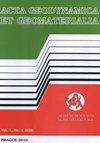Landslide detection and susceptibility mapping using geological and remote sensing data: A case study of Azad Kashmir, NW Sub-Himalayas
IF 0.8
4区 地球科学
Q4 GEOCHEMISTRY & GEOPHYSICS
引用次数: 1
Abstract
Azad Kashmir has undergone sever landslide episodes in the past. The main reasons behind the occurrence of landslides in this area are heavy rainfall, weak geological strata, seismic zones and active faults. Several episodes of roads blockage due to landslide is one of the major problem in this area, therefore, this study is carried out for landslide susceptibility analysis along the roads of Kotli to Trar Khel, Azad Kashmir, NW Sub-Himalayas. Geographic information system (GIS) is used to interpret remote sensing, geological strata and topographical data. Total ten anthropogenic and physical factors (aspects, fault, lithology, drainage density, curvature, distance to roads, landuse landcover, slope, seismic and elevation) were examined by Multi-criteria Decision Analysis (MCDA) technique. The thematic layers of all factors were prepared for the preparation of the final susceptibility map by using a weighted overlay method (WOM). The susceptibility map classified the study area into four susceptible classes of low, moderate, high and very high. The spatial analysis and result outcomes depicted that active faults, slope gradient and landuse landcover may facilitate landslide phenomena. The results were verified by landslide density analyses (LDA), receiver operator characteristics (ROC) and area under curve (AUC) with predictive accuracy of 77 % that is rated as satisfactory by many researchers.利用地质和遥感数据进行滑坡探测和易发性测绘:以喜马拉雅山脉西北部阿扎德克什米尔为例
阿扎德克什米尔地区过去曾发生过严重的滑坡事件。该地区发生滑坡的主要原因是强降雨、软弱地质层、地震带和活动断层。由于滑坡导致的几次道路堵塞是该地区的主要问题之一,因此,本研究针对Kotli至Trar Khel、Azad Kashmir、西北亚喜马拉雅山脉的道路进行了滑坡敏感性分析。地理信息系统用于解释遥感、地质地层和地形数据。采用多准则决策分析(MCDA)技术对10个人为和物理因素(断层、岩性、排水密度、曲率、道路距离、土地利用、坡度、地震和海拔)进行了研究。使用加权叠加法(WOM)为编制最终易感性图准备了所有因素的主题层。易感性地图将研究区域分为四个易感类别,即低、中、高和极高。空间分析和结果表明,活动断层、坡度和土地利用土地覆盖可能促进滑坡现象。滑坡密度分析(LDA)、受试者特征(ROC)和曲线下面积(AUC)验证了这一结果,预测准确率为77%,许多研究人员认为这是令人满意的。
本文章由计算机程序翻译,如有差异,请以英文原文为准。
求助全文
约1分钟内获得全文
求助全文
来源期刊

Acta Geodynamica et Geomaterialia
地学-地球化学与地球物理
CiteScore
2.30
自引率
0.00%
发文量
12
期刊介绍:
Acta geodynamica et geomaterialia (AGG) has been published by the Institute of Rock Structures and Mechanics, Czech Academy of Sciences since 2004, formerly known as Acta Montana published from the beginning of sixties till 2003. Approximately 40 articles per year in four issues are published, covering observations related to central Europe and new theoretical developments and interpretations in these disciplines. It is possible to publish occasionally research articles from other regions of the world, only if they present substantial advance in methodological or theoretical development with worldwide impact. The Board of Editors is international in representation.
 求助内容:
求助内容: 应助结果提醒方式:
应助结果提醒方式:


